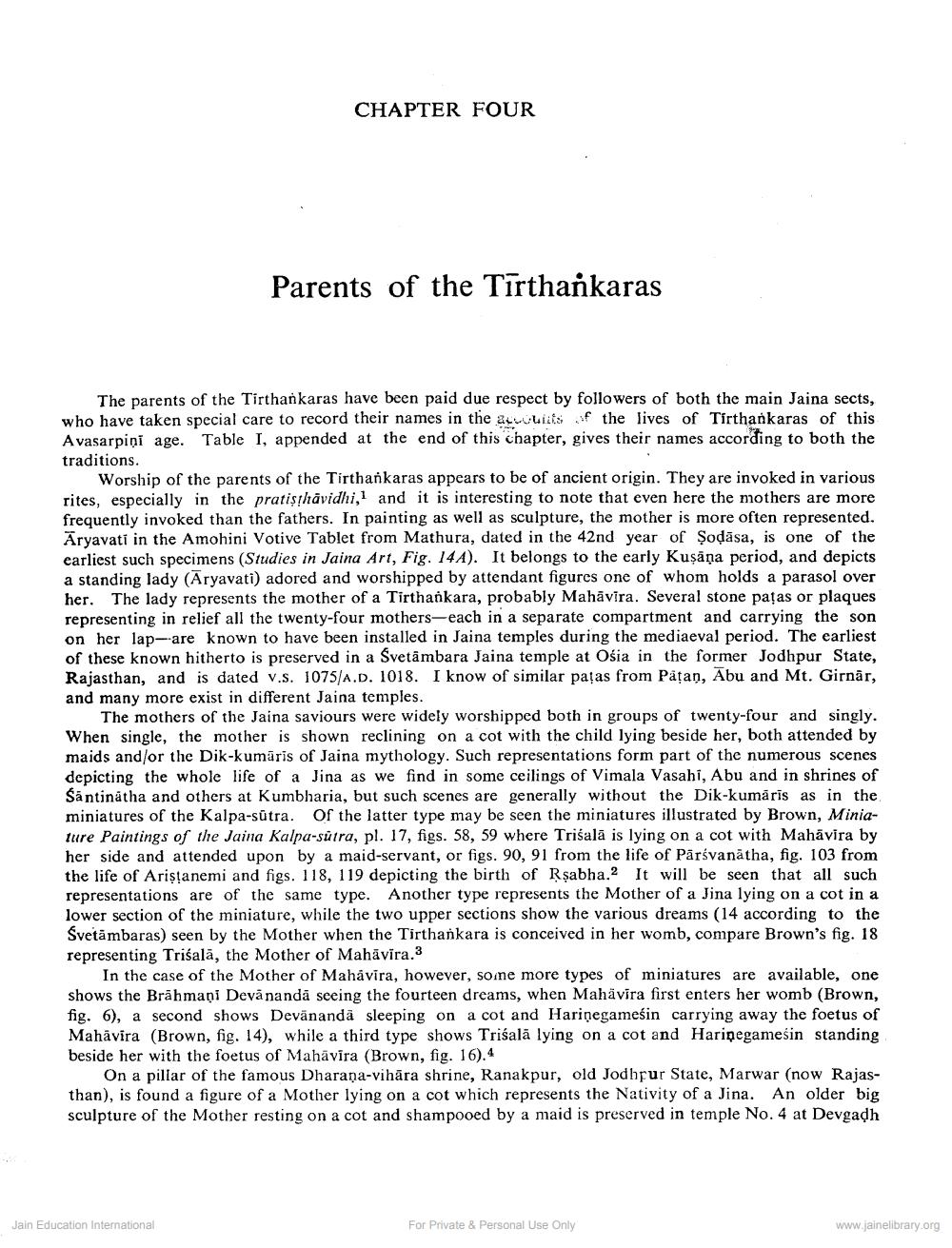________________
CHAPTER FOUR
Parents of the Tīrthankaras
The parents of the Tirthankaras have been paid due respect by followers of both the main Jaina sects, who have taken special care to record their names in the evils if the lives of Tirthankaras of this Avasarpiņi age. Table I, appended at the end of this chapter, gives their names according to both the traditions.
Worship of the parents of the Tirthankaras appears to be of ancient origin. They are invoked in various rites, especially in the pratisthāvidhi, and it is interesting to note that even here the mothers are more frequently invoked than the fathers. In painting as well as sculpture, the mother is more often represented. Aryavati in the Amohini Votive Tablet from Mathura, dated in the 42nd year of Şodāsa, is one of the earliest such specimens (Studies in Jaina Art, Fig. 14A). It belongs to the early Kuşaņa period, and depicts a standing lady (Aryavati) adored and worshipped by attendant figures one of whom holds a parasol over her. The lady represents the mother of a Tirtharkara, probably Mahāvira. Several stone pațas or plaques representing in relief all the twenty-four mothers-each in a separate compartment and carrying the son on her lap-are known to have been installed in Jaina temples during the mediaeval period. The earliest of these known hitherto is preserved in a Svetambara Jaina temple at Ośia in the former Jodhpur State, Rajasthan, and is dated v.s. 1075/A.D. 1018. I know of similar pațas from Påsan, Abu and Mt. Girnar, and many more exist in different Jaina temples.
The mothers of the Jaina saviours were widely worshipped both in groups of twenty-four and singly. When single, the mother is shown reclining on a cot with the child lying beside her, both attended by maids and/or the Dik-kumāris of Jaina mythology. Such representations form part of the numerous scenes depicting the whole life of a Jina as we find in some ceilings of Vimala Vasahi, Abu and in shrines of Santinātha and others at Kumbharia, but such scenes are generally without the Dik-kumāris as in the miniatures of the Kalpa-sútra. Of the latter type may be seen the miniatures illustrated by Brown, Miniature Paintings of the Jaina Kalpa-sútra, pl. 17, figs. 58, 59 where Trišalā is lying on a cot with Mahavira by her side and attended upon by a maid-servant, or figs. 90, 91 from the life of Pārsvanatha, fig. 103 from the life of Aristanemi and figs. 118, 119 depicting the birth of Rsabha. It will be seen that all such representations are of the same type. Another type represents the Mother of a Jina lying on a cot in a lower section of the miniature, while the two upper sections show the various dreams (14 according to the Svetambaras) seen by the Mother when the Tirthankara is conceived in her womb, compare Brown's fig. 18 representing Trisalā, the Mother of Mahāvira.3
In the case of the Mother of Mahavira, however, some more types of miniatures are available, one shows the Brāhmani Devananda seeing the fourteen dreams, when Mahävira first enters her womb (Brown, fig. 6), a second shows Devänanda sleeping on a cot and Harinegamesin carrying away the foetus of Mahāvira (Brown, fig. 14), while a third type shows Trišalá lying on a cot and Harinegamesin standing beside her with the foetus of Mahavira (Brown, fig. 16).4
On a pillar of the famous Dharana-vihāra shrine, Ranakpur, old Jodhpur State, Marwar (now Rajasthan), is found a figure of a Mother lying on a cot which represents the Nativity of a Jina. An older big sculpture of the Mother resting on a cot and shampooed by a maid is preserved in temple No. 4 at Devgadh
Jain Education International
For Private & Personal Use Only
www.jainelibrary.org




